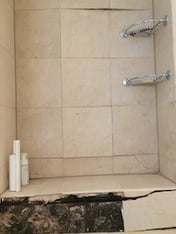We are often consulted on situations where an inappropriate substrate has resulted in a failure to the tiling and now needs to be replaced. So, we would like to share with you the most common problems we come across and our top tips for protecting your new bathroom from water damage.
There are four common myths or misconceptions that inevitably lead to problems. We will discuss these below and explain why.
But first, it is worth noting that there is an important difference between "waterproof" and "water resistant".
Water/Moisture Resistant: When talking about bathroom tiling, if a material is water or moisture resistant, it means that the material is not damaged and does not deform if it gets damp. It does not mean that water or moisture cannot pass through it.
Waterproof: A waterproof material will prevent water from passing through it.
Myth 1: Tiles, tile adhesive and tile grout will make the shower enclosure waterproof. NOT TRUE!
Most tile adhesives and grout are water resistant but not waterproof. They do not swell, crack or get damaged if they get wet but they won't stop water from passing through onto the substrate. And if the substrate is not waterproof, the water will then pass through the substrate and may lead to further problems. The key to success is to make sure the substrate itself is waterproof before the tiles are installed.
Myth 2: "Green" plasterboard is suitable for tiling in bathrooms. NOT TRUE!
It is a common misconception that the green plasterboard is OK for bathrooms because it is described as moisture resistant. There are three reasons why not.
- it will not stop water from passing through - remember the definition of "resistant" as opposed to "waterproof".
- it does eventually deform when exposed over a prolonged period to moisture and
- the paper face cannot take the weight of the average natural stone tile.
You should never use any type of plasterboard for tiled areas. Even some of the green plasterboard web sites tell you it is not to be used in wet areas!
One of our earlier blogs about installation goes into more detail.
Myth 3: plywood is a suitable substrate - NOT TRUE!
 I have seen plywood used to build the substrate in bathrooms many times. It is used because it is easy to build the framework for shower enclosures, bath surrounds etc. and it adds strength to stud walls. It sounds ideal and for the structural work, it is really useful. But for tiling, it can cause huge problems. When wet, the plywood swells and the colour can leach through into the grout and tiles.
I have seen plywood used to build the substrate in bathrooms many times. It is used because it is easy to build the framework for shower enclosures, bath surrounds etc. and it adds strength to stud walls. It sounds ideal and for the structural work, it is really useful. But for tiling, it can cause huge problems. When wet, the plywood swells and the colour can leach through into the grout and tiles.
This image shows a shower enclosure tiled with Crema Marfil limestone tiles. The shower bench and surrounding structure was built with plywood and the tiles were stuck directly to it. You can see how the tiles on the back wall have started to come away and those on the shower seat have fallen off. Water found its way to the plywood and caused it to swell and the layers of laminate in the ply separated and debonded. This bathroom was installed only a few years ago and now has to be completely replaced because of the damage done by the water. A simple but effective solution is to use Marmox boards in place of ply or, at least, to fix the Marmox boards on top of the ply to act as a waterproof barrier.
The new bathroom will be constructed using waterproof tilebacker boards (Marmox) instead of ply to prevent a recurrence. The joins between the boards are sealed with Marmox Joint Tape so that the whole space is fully tanked.
Thankfully, British Standard BS 5385-1 was revised in 2018 and tiling directly onto plywood no longer meets the British Standards.
Myth 4: A coating of PVA will waterproof the substrate - NOT TRUE!
This is another common misconception. I've often heard it said that PVA could be used to prime plasterboard or plywood in preparation for tiling. In short, PVA is water soluble and even dried PVA will soften and become viscous when in prolonged contact with water. It will slacken the bond between the adhesive and the substrate and ultimately cause a failure.
These misconceptions can cause failures in all types of tiling and not just to natural stone.
Every situation is slightly different so if you need any help specifying a suitable substrate then we are happy to offer advice on your individual project. Click below to find out more.
Thanks for reading.
Steve Turner
0345 260 8070
Amarestone
P.S. - get the next blog direct to your inbox by entering your email address in the box on this page.


